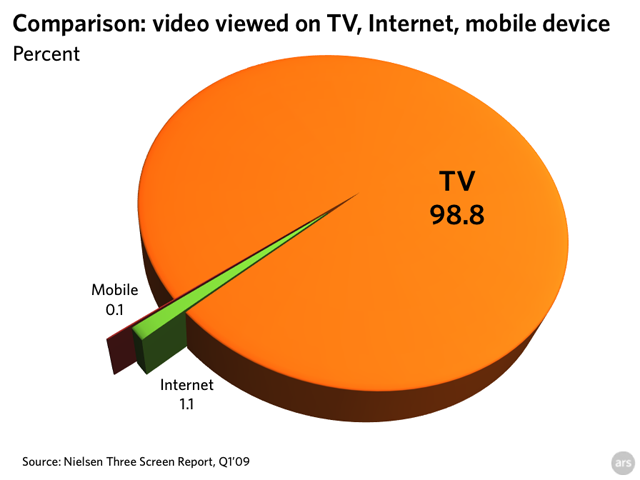The latest report from ratings firm Nielsen reveals that the number of web and mobile video viewers is up, and the time spent watching video on the internet is increasing. But the overwhelming majority of video is still viewed on a television. And Americans are watching more TV than ever.
About 131 million people are watching an average of three hours of video per month via the Internet, according to Nielsen's data. That's up from 116 million watching a monthly average of two hours this same time last year. Additionally, about 13 million mobile phone subscribers—up 52 percent from nearly 9 million last year—report watching an average of 3.5 hours of video a month on a mobile phone (time measurements are not available from Q1 last year).
Those are significant increases. The main factors fueling these changes are increases in broadband availability and bandwidth nationwide, increased exposure of services like Hulu and YouTube, and an increased proliferation of advanced, video-capable smartphones for mobile phone viewing.
But those increases pale in comparison to television, which Americans watch more than ever, averaging about 153.5 hours in front of the boob tube in a month. "Television is still the dominant choice for Americans who watch video," according to Nielsen's report. "Almost 99 percent of the video watched in the US is still done on television." You can see how the amount of TV watched by Americans dwarfs the small amount viewed online and the even smaller amount viewed via a mobile phone in the chart below.

It should come as little surprise; the TV is still the center of most living rooms, and is connected to cable boxes, DVRs, DVD players, and video game consoles (among other sources). As Conan O'Brien quipped—rather ironically, given Nielsen's results—in a recent commercial for his move to The Tonight Show, "Television allows you to watch things just as you would on your computer or cell phone, except while seated in a more comfortable chair."
Anecdotally, my own TV viewing is split between cable, watching DVDs, and streaming movies and TV shows from both Netflix and Amazon VOD via my Roku player. I have streamed hundreds of movies and TV episodes to my TV from Netflix, and streamed exactly one to my computer. And while I've watched a few TV shows via Hulu, I'd just as soon stream it from Netflix or Amazon—even if I have to pay extra. It looks better on my TV screen, sounds better pumped through my stereo, and—like Conan says—is more comfortable to watch while stretched out on my couch.
Other interesting notes from the report:
- Average monthly TV viewing increases from about 108 hours for kids aged 2-11 to over 210 hours for the 65 and over set.
- The biggest users of DVRs are folks aged 25-45, watching about 11-12 hours of time-shifted television per month.
- Unsurprisingly, the group watching the most video online are those aged 18-24, clocking just over five hours a month on average.
- And the group among those watching mobile video on mobile phones that are spending the most time squinting at a tiny screen are those aged 13-17, watching an average of 6.5 hours per month—more than double the overall average of three hours per month.
Of course, Nielsen's data doesn't account for the amount of video pulled down via file sharing. But with so many eyes planted for so long in front of a TV, it's a wonder why such a fuss is made about the Internet and how it will spell the death knell for TV networks. There's no doubt that consumers are increasingly expecting to be able to watch video when and where they want, as evidenced in particular by the online and mobile viewing habits of the younger generation. But the television still rules the video viewing roost, for now and the foreseeable future.
Further Reading:
- A PDF is available of Nielsen's A2/M2 Three Screen Report for Q1'09.
Listing image by Photo illustration includes an image by Wynand Delport.
reader comments
45